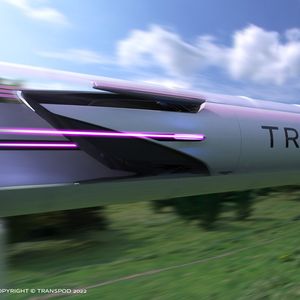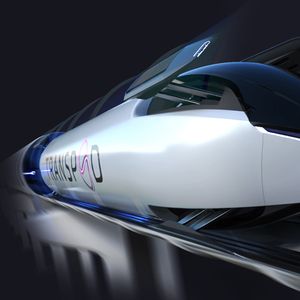
The Hyperloop Gets a Fresh Injection of Excitement with New Player, Global Partnership
Is the hyperloop making inroads? With a new entrant in the race for high-speed, underground travel and a newly formed joint venture among seven hyperloop companies, it may be closer than ever.
Toronto-based TransPod recently introduced The FluxJet, its fully electric “hybrid between an aircraft and a train,” and announced the formation of The Hyperloop Association. The partnership includes Hardt, Hyperloop One, Hyperloop Transportation Technologies, Nevomo, Swisspod Technologies, and Zeleros.
 The Brussels-based association will work closely with the European Commission, the European Parliament, and Europe’s Rail Joint Undertaking. The European Commission will “initiate the work on the hyperloop regulatory framework, a significant milestone for the industry, not just in Europe but worldwide,” said Ben Paczek, inaugural president of The Hyperloop Association. “In the upcoming months, we expect major developments in the hyperloop space.”
The Brussels-based association will work closely with the European Commission, the European Parliament, and Europe’s Rail Joint Undertaking. The European Commission will “initiate the work on the hyperloop regulatory framework, a significant milestone for the industry, not just in Europe but worldwide,” said Ben Paczek, inaugural president of The Hyperloop Association. “In the upcoming months, we expect major developments in the hyperloop space.”
 TransPod expects to eventually release pods every two minutes. They’ll have an initial capacity of 54 passengers or 10 tons of cargo, with the ability to scale up by “virtual coupling.” This will allow “multiple vehicles to be dispatched simultaneously in a train-like configuration, connected through a virtual system similar to adaptive autopilot,” they said.
The FluxJet will rely on technological advancements and innovations in propulsion, clean energy, and “contactless power transmission,” so it can pull power from the existing electric grid through magnetic fields. That means the ability to travel at more than 620 miles per hour — faster than a jet and three times what a high-speed train can do — while emitting zero emissions.
TransPod expects to eventually release pods every two minutes. They’ll have an initial capacity of 54 passengers or 10 tons of cargo, with the ability to scale up by “virtual coupling.” This will allow “multiple vehicles to be dispatched simultaneously in a train-like configuration, connected through a virtual system similar to adaptive autopilot,” they said.
The FluxJet will rely on technological advancements and innovations in propulsion, clean energy, and “contactless power transmission,” so it can pull power from the existing electric grid through magnetic fields. That means the ability to travel at more than 620 miles per hour — faster than a jet and three times what a high-speed train can do — while emitting zero emissions.
 According to a feasibility study, TransPod’s ultra-high-speed transportation system will also create as many as 140,000 jobs while adding $19.2B to the GDP. The cost for passengers to travel on the FluxJet is expected to be 44% less than the cost of a plane ticket, and the system would also reduce carbon dioxide emissions by 636,000 tons per year once it’s finished.
Preliminary construction has begun on the TransPod Line, which will initially connect the Canadian cities of Calgary and Edmonton. The 175-mile trip will take just 45 minutes. TransPod’s $550 million infusion from Broughton Capital Group in cooperation with China-East Resources Import & Export Co. will help fund the test track and further research and development.
Elon Musk’s The Boring Company and Hyperloop One are the two most notable names in the hyperloop world, but so far, the talk has outpaced the results. That only adds to the excitement for TransPod.
According to a feasibility study, TransPod’s ultra-high-speed transportation system will also create as many as 140,000 jobs while adding $19.2B to the GDP. The cost for passengers to travel on the FluxJet is expected to be 44% less than the cost of a plane ticket, and the system would also reduce carbon dioxide emissions by 636,000 tons per year once it’s finished.
Preliminary construction has begun on the TransPod Line, which will initially connect the Canadian cities of Calgary and Edmonton. The 175-mile trip will take just 45 minutes. TransPod’s $550 million infusion from Broughton Capital Group in cooperation with China-East Resources Import & Export Co. will help fund the test track and further research and development.
Elon Musk’s The Boring Company and Hyperloop One are the two most notable names in the hyperloop world, but so far, the talk has outpaced the results. That only adds to the excitement for TransPod.
 “All the hard work over the past few years has led to this milestone moment where talk is becoming a reality,” said Sebastien Gendron, co-founder and CEO of TransPod. “The technology is proven, and we have the confidence of investors, governments, and partners to continue pushing forward to redefine transportation effectively.”
“All the hard work over the past few years has led to this milestone moment where talk is becoming a reality,” said Sebastien Gendron, co-founder and CEO of TransPod. “The technology is proven, and we have the confidence of investors, governments, and partners to continue pushing forward to redefine transportation effectively.”
SHARE





